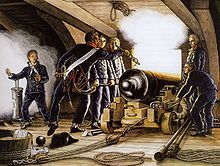17:
97:
nine feet (2.7 m) in length. The size of the gun often depended on the size of the ship that carried it, and how many of the guns the ship was to carry. In 1782, another change was made to the design of the long nine; it could be manufactured at a length of nine feet six inches (2.9 m).
74:
Once in position, a small hole in the back of the cannon is lined with a small amount of (very fine in comparison to the main charge, so it burns fast) gunpowder. This process is called priming. From there, the cannon operator stood back from the cannon and held a string until the cannon was lined up
96:
in 1703. In the early 1700s, long guns started to dwindle in usage, but came back to prominence in 1761 when the Board of
Ordnance changed its primary restriction of the size of long nines. The new protocol for manufacturing long guns included five lengths that ranged from seven feet (2.1 m) to
109:
used in the naval long guns did not offer as much variety as the size of the gun did. The only ammunition used was a simple nine pound cannonball, called a nine pounder. Nine pounders were the lightest of all cannon ammunition, and therefore allowed long nines to have increased range. This played a
66:
Long guns, being extremely heavy when fully loaded and ready to fire, had to be moved into position after being loaded. This typically took the full effort from the group of men attempting to transport it. The cannon is then pushed forward until it is in full contact with the side of the ship, and
62:
is put in. Once the barrel is clean, the gunpowder is put into the base of the cannon, either loosely or in cloth bags. A piece of cloth or rope is put in after the gunpowder to assure that it stays tightly packed. This is quite a coarse grained powder for a longer duration of burn. The cannonball
57:
are fired through a laborious process that involves the help of many people. It begins by cleaning out the barrel of the cannon with a wet swab. This helps to ensure that any left over embers from the last firing are extinguished before the
43:. The long gun was known for its increased range and improved mobility in comparison to its larger precursors. This allowed the long gun to establish itself as the best form of artillery to pursue an enemy.
63:
follows and is topped off with a piece of wool or cotton. This secondary piece of cotton helps to keep the cannonball in place and secure with the explosives.
79:
in order to fire the gun. The gun could typically only be fired two to three times in five minutes, so it was important that it hit its target.
46:
In informal usage, the length was combined with the weight of shot, yielding terms like "long nines", referring to full-length, 9-pounder guns.
92:
Naval long guns, or long nines were originally made in only two sizes, eight feet (2.4 m) or nine feet (2.7 m). This was set by the
119:
173:
168:
Rodger, Nicholas (2004). The
Command of the Ocean:A Naval History of Britain 1649-1815. Penguin Books. p. 420.
110:
large part behind the purpose of the gun, which was to chase and pursue a fleeing enemy ship or fleet.
210:
21:
186:
8:
149:
144:
139:
134:
129:
124:
169:
93:
75:
with the enemy's ship. Once aimed in the right direction, the operator will pull the
39:
mounted by a sailing vessel, so called to distinguish it from the much shorter
204:
106:
59:
40:
68:
76:
54:
36:
28:
20:
Firing of an 18-pounder long gun aboard a French ship, by
16:
202:
82:
15:
203:
49:
13:
120:Naval artillery in the Age of Sail
87:
67:the barrel is pointed through the
14:
222:
179:
162:
1:
155:
100:
7:
113:
10:
227:
83:British gun specifications
35:was the standard type of
24:
22:Louis-Philippe Crépin
19:
150:36-pounder long gun
145:30-pounder long gun
140:24-pounder long gun
135:18-pounder long gun
130:12-pounder long gun
125:8-pounder long gun
25:
94:Board of Ordnance
50:Firing a long gun
218:
195:
194:
183:
177:
166:
226:
225:
221:
220:
219:
217:
216:
215:
211:Naval artillery
201:
200:
199:
198:
187:"The Long Nine"
185:
184:
180:
167:
163:
158:
116:
103:
90:
88:Size regulation
85:
52:
12:
11:
5:
224:
214:
213:
197:
196:
178:
160:
159:
157:
154:
153:
152:
147:
142:
137:
132:
127:
122:
115:
112:
102:
99:
89:
86:
84:
81:
51:
48:
27:In historical
9:
6:
4:
3:
2:
223:
212:
209:
208:
206:
192:
188:
182:
175:
174:0-14-028896-1
171:
165:
161:
151:
148:
146:
143:
141:
138:
136:
133:
131:
128:
126:
123:
121:
118:
117:
111:
108:
98:
95:
80:
78:
72:
70:
64:
61:
56:
47:
44:
42:
38:
34:
30:
23:
18:
190:
181:
164:
104:
91:
73:
65:
53:
45:
32:
26:
191:Age Of Sail
156:References
107:ammunition
101:Ammunition
41:carronades
60:gunpowder
31:usage, a
205:Category
114:See also
69:gun port
33:long gun
77:lanyard
55:Cannons
172:
37:cannon
29:naval
170:ISBN
105:The
207::
189:.
71:.
193:.
176:.
Text is available under the Creative Commons Attribution-ShareAlike License. Additional terms may apply.
